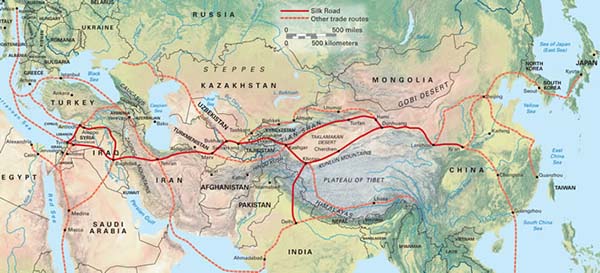In his visit to Kazakhstan in September 2013, President Xi Jinping of China called for joint development of an "Economic Belt along the Silk Road" which has been enthusiastically received both at home and abroad.
The "Belt" initiative is the continuation and development of the spirit of the ancient Silk Road. Over 2,000 years ago, the industrious and brave people on the Eurasian continent opened several trade routes connecting major civilizations across Asia, Europe and Africa. Together, they were referred to as the "Silk Road" by succeeding generations. Such links of mutual emulation via the Silk Road made exchanges of goods, know-how, people and ideas possible, promoted the economic, cultural and social progress in the various countries, facilitated dialogue and integration of different civilizations, and left behind brilliant pages in human history. Facing a complex international and regional landscape, the Silk Road has become all the more important and precious as a symbol of peace, cooperation, openness, inclusiveness, mutual learning and resilience. It is all the more crucial for the international community to embrace the spirit of the ancient Silk Road, bring it up to date, instill greater dynamism, and realize its value in this new age, thus creating a new material and cultural wealth for humanity.
Working jointly for the "Belt" initiative meets the trend of the times for regional cooperation. Regional integration is an unavoidable phase towards economic globalization. The flourishing cooperation in Asia has boosted peace and development in the region. The "Belt" initiative, by linking Central Asia, South Asia and West Asia, will contribute to greater connectivity and complementarity across the sub-regions, thus bringing Pan-Asian and Eurasian regional cooperation to a new level. Eurasian countries, all in a critical state of transition and upgrading, desperately need to unleash their potential demand and that of the region, create still more growth points and make their economies more dynamic and more resilient to fend off risks. The "Belt" initiative foresees infrastructure development and systemic innovation, which conduces to an improved business environment in relevant countries and the region as a whole, to an orderly and unimpeded flow of production factors and their improved distribution, to the development of landlocked countries and the remote areas of various countries, to lowering costs and trade and investment barriers, and to providing greater drive for reform and opening-up in the various countries.
The "Belt" initiative comes as a highlight in China's diplomacy in the new era, especially its neighborhood diplomacy. Neighborhood diplomacy occupies the primary position in China's overall diplomacy. The state of China's relations with the rest of the world finds expression, first and foremost, in the changing relations between China and its neighbors. China has adhered to the policy of building friendship and partnership with the neighbors and abided by the principle of bringing harmony, security and prosperity to the neighborhood. We hope to participate more actively in international affairs including those in the neighborhood through the "Belt" initiative, highlighting the concept of amity, sincerity, mutual benefit and inclusiveness, providing more public goods and playing a more effective role as a responsible major country. The initiative will also help dovetail China, its neighbors and other Eurasian countries on the issue of development strategies, and build an even closer network of common interests, whereby China and all countries in the neighborhood can benefit from each other's development and the common development of the whole continent.
The "Belt" initiative features "five links" and focuses on result-oriented and project-based cooperation, all aimed at bringing tangible benefits to the people in the region. The first of the "five links" is policy. Countries can discuss strategies and policies on economic development and in the spirit of seeking common ground while shelving differences, formulate corresponding plans and measures for cooperation. The second "link" is road. There is need for China and its neighboring countries to improve on their cross-border transportation infrastructure, and effectively address the existing inadequacies of connectivity and transportation in regions targeted by the project. The third "link" is trade. We should study issues of trade and investment facilitation while making proper arrangements accordingly, promote economic circulation and improvement in the region, unleash still greater trade and investment potential of participating countries and make the regional cooperation "pie" still bigger. The fourth "link" is currency. We should promote greater trade settlement in local currencies and more currency swap schemes, strengthen bilateral and multilateral financial cooperation, set up financial arms for regional development, and make the region’s economy more competitive globally. The fifth "link" is people. China and the neighboring countries need to shore up popular support for their state-to-state relations, promote inter-civilization dialogue, enhance exchanges, understanding and friendship.
When President Xi Jinping proposed the "Economic Belt along the Silk Road", Afghan President Karzai positively responded to this initiative. As an important neighboring country in the west of China, Afghanistan used to be the traffic hub of central Asia, south Asia and west Asia. We wish Afghanistan to play an active role in the formation of the "Silk Road Economic Belt", and make due contribution to regional economic prosperity. Russia, Kazakhstan and other Central Asian countries, Turkey and other West Asian countries, as well as India, Pakistan and other South Asian countries called the Economic Belt along the Silk Road an important, constructive and timely initiative that meets the trend of the times and suits needs of all sides. They expressed readiness for active participation. The "Belt" initiative is not a private matter for China alone. It is a cause shared by all countries. The "Belt" initiative, along with their preliminary studies, is open to constructive opinions and suggestions by other countries with a view to enriching and improving the concept, vision and planning of the initiatives. Let us pool our wisdom and resources, work together to write a new chapter of the Silk Road and build a happy life for all of us.

